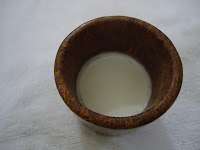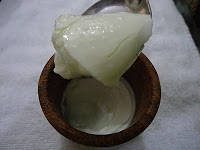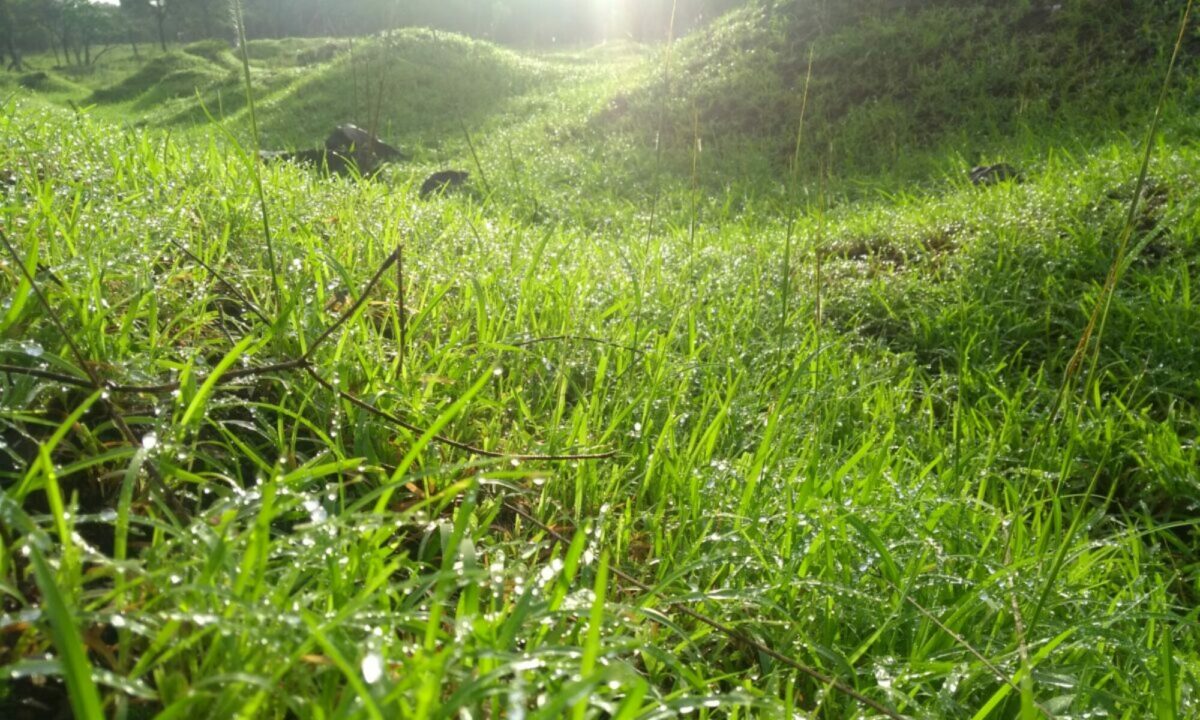Fossil stone a.k.a Habur limestone can be seen as part of the flooring in the Jain Temples @ the Golden Fort at Jaisalmer. Its a lovely reddish
brown with interesting dark patterns on it. Apparently the only other site its found is @ Fatehpur Sikri.
Naturally
I purchased a tiny glass (was left poorer by Rs 300 for it) just to
test this fantastic property.. Some vendors sold small pieces of stone that they
claimed when kept in plain milk would convert it to dahi…If dahi is not your forte then simply drink water stored in this glass as it is said to impart medicinal properties.
Once back home, the first thing I did was to pour a small quantity of milk in
this glass. This was at about 3PM. It was pretty cool in Pune hence I did not
observe any change for about 8 hours. I decided to wait overnight not
really knowing what to expect. I gave it the usual treatment I administer to set dahi in winter (warm surroundings).

Come
morning, I was absolutely stunned to see that the milk had thickened
and there was a bit of what looked like whey on the sides. On dipping a spoon I could pick up firmly set milk which had the texture
and colour of regular dahi. The taste however was neither sour nor
sweet and had a peculiar ‘earthy’ flavour. On leaving it at room temperature for more time, the ‘dahi‘ did not turn sour.

Have you tried to set dahi in a fossil stone (Habur limestone) container? What happened? Do tell us!
Our
research showed that this is the Habur limestone. Here are some links to
published research by Indian scientists on claims to its property of curdling milk.
http://docs.google.com/viewer?a=v&q=cache:dTiE5qLTCvQJ:www.ias.ac.in/currsci/sep102005/729.pdf+jaisalmer+fossil+stone+curd&hl=en&gl=in&pid=bl&srcid=ADGEESjpXT6XwwLEtjqeKNSnhtq3jEEGRSVJUaPCKH4kvfGgOxGbBP822FllVCKd1JJ3Zs1KbUUUEV3hrk9hPvokSGW2t_LHB76t72VfkI-2Dwo8SMW0V3WJJmjMSAvd_GYy6KKDg1Lr&sig=AHIEtbQL7k14rvA7Daw7-Vg50P33qfxMrw
http://docs.google.com/viewer?a=v&q=cache:17VQoyridn8J:www.ias.ac.in/currsci/nov252005/1647.pdf+jaisalmer+fossil+stone+curd&hl=en&gl=in&pid=bl&srcid=ADGEESjSP7UylYPAKlrbRAT5FlSopSuEhedoOvvkdQRS6OgD_7n9JpijoqeilBe4hjfmNYMBn-RZf969PRAfOvtTuFzrGgJkY8z5y5tSNGPfbxJl7qLXZ0z9rNE9-XBswZzgqZv52qBZ&sig=AHIEtbT9d-dgdjpsGMiCuldDqBmw7wlEcw
I am not a
scientist so I cant say it these are million year old bacteria at work!
However my experiment did yield part of the claimed result.
Amazing aint’ it?
Cheers!

I had tried same with pyramid stone. But the curd was smelling very bad and was not eatable. So i had kept that stone in my home's Showcase.
same here. its selling tactics Jaisalmer locals are using to increase their income. Bowl lying in my showcase as its losing its color even after putting milk in it (Even after many wash).
I have used the stone to make curd. It is really true. It makes curd.
Its not correct to blame the stone. I myself picked up one cone at a local shop in Jaisalmer in December, 2016, For the last 15 days the curd obtained is fanstastic in taste and shape. I does not smell at all, does not have water and tastes good. I plan to pick up some more through my friends who are also eager and plan to visit shortly.
WE BOUGHT A SANDSTONE BOWL TO SET THE YOGURT. WE WERE TOLD THAT WE HAVE TO USE A STARTER AND THAT THE DAHI WILL SET WITHOUT ANY WHEY. WELL THE DAHI DID SET, BUT WITH THE USUAL AMOUNT OF WHEY WHICH WE GET EVEN WHEN WE SET IT IN A REGULAR GLASS CONTAINER.
Thank you for your thoughts G Roy.
Thanks all! 🙂
I just read this somewhere… So limestones have a lot of pores compared to other stones and since the place where this stone is found that is habur in jaisalmer was sparsely populated, they generally faced problems to make curd. So they used to store curd in the habur stone made vessels or dropped a chunk of the stone in curd and once the curd was stored in the pores of the limestone,a thin lining of curd making bacteria always remained in these pores even after the curd initially filled into the container was removed.So they either dipped the limestone in the milk the next day or stored milk in the container to make curd.The milk entering the tiny pores would react with the curd forming bacteria present from the previous introduction of curd thus forming curd. And hence the myth still prevails just to sell these carved limestones and make a living .😀
I bought one recently…do we have to heat milk before pouring into it..
I have used it and it works. There are two types or stones available one of them is natural and the other polished. The polished stone cannot be used while the natural stone works perfectly fine for making curd and tastes exactly like curd.
Thanks all!
I bought one sand stone glass from Jaisalmir last year. I was told if I keep water overnight & drink it next morning it will reduce my knee pain. I was not convinced at all. But after using it for several months my knee pain has gone substantially.